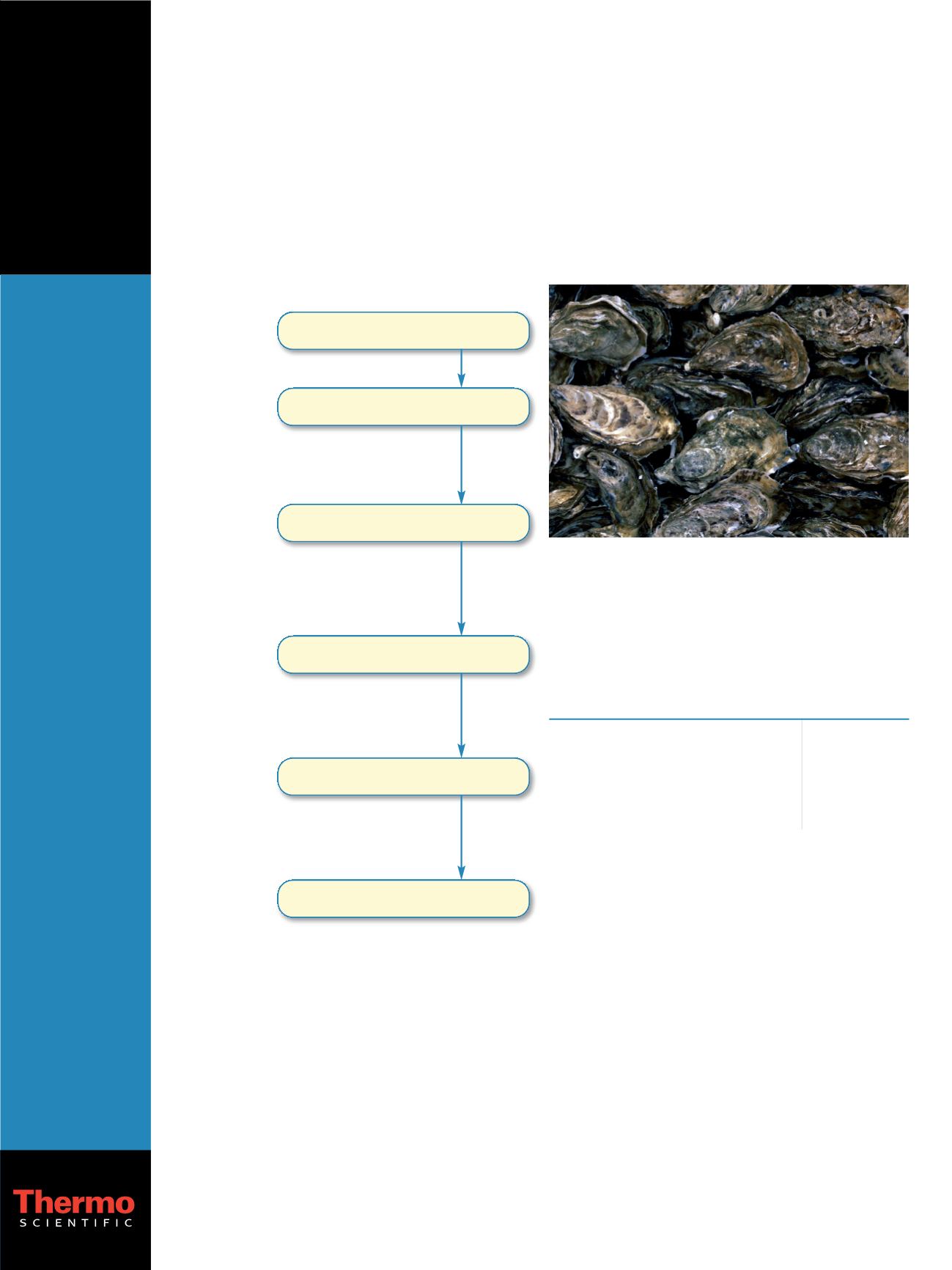
Determination of Polycyclic Aromatic
Hydrocarbons (PAHs) and Aliphatic
Hydrocarbons in Oysters by GC-MS/MS
Klaus Mittendorf, Laszlo Hollosi, Ebru Ates, Katerina Bousova, Thermo Fisher Scientific Food Safety Response Center, Dreieich, Germany
Eric Phillips, Hans-Joachim Huebschmann, Thermo Fisher Scientific, Austin, TX, USA
James Chang, Thermo Fisher Scientific, San Jose, CA, USA
1. Schematic of Method
2. Scope
This method can be applied to oysters to detect the presence
of aliphatic hydrocarbons and PAH contamination from
crude oil found in the Gulf of Mexico in late May 2010.
From the profile using GC-MS/MS, the method can be used
to characterize the source of contamination. The method
can give a semi-quantitative indication of whether levels of
PAHs exceed safety limits for human consumption of oysters.
3. Principle
The method uses a liquid extraction of oysters with hexane,
followed by a clean-up on a silica-SPE-cartridge. The sample
is fortified with appropriate labeled internal standards
and analyzed by simultaneous GC-MS/MS using a
Thermo Scientific TSQ Quantum XLS triple quadrupole
mass spectrometer system. Aliphatic hydrocarbons and PAHs
of food safety significance are measured and compared with
the profile from crude oil collected from the Gulf of Mexico
in late May 2010.
4. Reagent List
Fisher Scientific USA
Part Number
4.1
Acetone
A9491
4.2
Cyclohexane
C6201
4.3
Hexane
H3021
4.4
SPE Hypersep SI, 200 mg/3 mL
03251270
4.5
Toluene
AC176850010
5. Calibration Standards
5.1 PAHs
Acenaphthene – Ace (Sigma)
Acenaphthylene – Acy (Sigma)
Anthracene – Ant (Sigma)
Benz[a]anthracene – B(a)A (Sigma)
Benzo[a]pyrene – B(a)P (Sigma)
Benzo[b]fluoranthene – B(b)F (Sigma)
Benzo[g,h,i]perylene – B(g,h,i)P (Sigma)
Benzo[k]fluoranthene – B(k)F (Sigma)
Chrysene – Chr (Sigma)
Dibenz[a,h]anthracene – D(a,h)A (Sigma)
Fluoranthene – Flu (Sigma)
Fluorene – Fln (Sigma)
Indeno[1,2,3-cd]pyrene – I(1,2,3-c,d)P (Sigma)
Naphthalene – Naph (Sigma)
Phenanthrene – Phe (Sigma)
Pyrene – Pyr (Sigma)
Key Words
• TSQ Quantum XLS
• Aliphatic
Hydrocarbons
• Gulf Oil Spill
• Oil Contamination
• Oyster Extraction
• PAHs
Method: 51980A
Sample (Oyster) Homogenization
Sample 2.0 g + Isotopically Labeled IS
Liquid Extraction
Clean-up
Concentration
GC-MS/MS
1.
Weigh sample in 15 mL glass tube and add IS
2.
Vortex samples (10 s)
3.
Equilibrate 10 min
4.
Extract with 5 mL hexane in ultrasonic bath (10 min)
5.
Transfer in round flask with pasteur pipette
6.
Repeat steps 4 and 5 three more times
7.
Evaporate to about 1 mL
8.
Condition SPE with 3 mL hexane
9.
Apply sample
10.
Elute up to 5 mL with hexane
11.
Gently evaporate under nitrogen stream to dryness
12.
Reconstitute in 180 µL of cyclohexane + 20 µL of
injection/surrogate standard.


